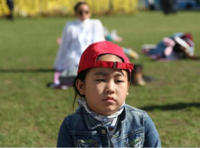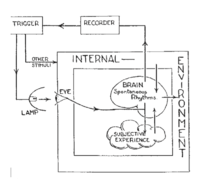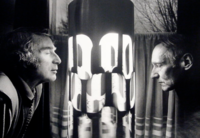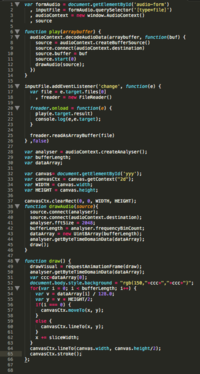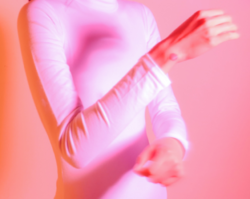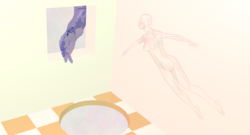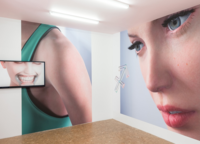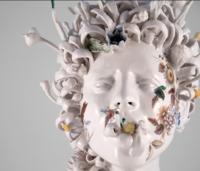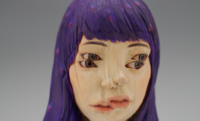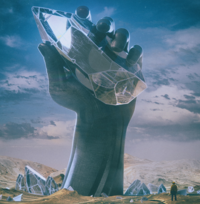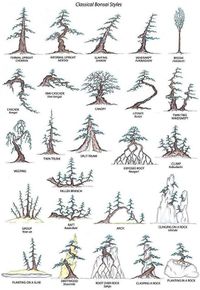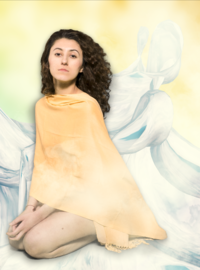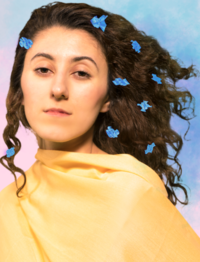User:Stonestone/RWRM-11
Me
I am Ying Shi (石颖), I work with still and moving images since 2010, including 3d, 2d, photography, short films and documentaries. In this thesis, I will discuss the style and techniques I have been using and the things which motivate me to make work. I now make computer images with videos and photos of people in soft, bright colours. This process began with a series of works called ‘Space-Out’, in which I aimed to make people feel more relaxed, from then on, I became interested in how my art could change the way people feel. As part of this process I researched the Gysin, Burroughs Dreammachine. In this thesis, I will discuss how I am developing myself and my current projects in relation to previous work and to work by others that has influenced me.
[S: in the abstract you need to state an overall theme]
Introduction
From a film making background, I worked as a freelancer film maker when I was in Beijing since 2011. In 2014, I was too tired and got depressed from the intense working atmosphere and the dead loop of my life in Beijing which was basiclly like waking up by my working computer, sitting whole day and opening packages I ordered on Alibaba, eating only takeouts I ordered on Apps. Without any struggleling I got this idea that maybe there were more things to see in my life. In July 2015, I arrived the Netherlands and staring my master Media Design program in Piet Zwart Institute Willem de Kooning Academy. That was the turning point for my idea of making works.
After I started my master education, I got more ideas of making art works using different technique which I even never heard or thought about. I was like a baby, felt couious about anything I saw and started to learn codes and more softwares which I thought too far away from my life. And I actually started doing my art project after I got here. Art seems like a normal thing, which is a part of people's life, and people can accept more ideas even though they might not like them in Europe. My mind now is going 'crazier and crazier' and I can't stop looking at and tying to do more things. It is a feeling I never have had before. I feel like I am making things which have been in my mind for a long time but I did not see it, now they are keeping coming out.
Works
Dream-machine
The first project I did in my master is called Space-Out. During the beginning of my study, I always wanted to try coding in which I knew nothing. This project is an research of the feeling of space-out.
On October 27th 2016 in South Korea, the first ever Space-Out Competition was held, which would be one of the most peaceful competition in the world. Candidates must maintain a certain and stable heart rate while being in a status of space-out. Finally, a nine-year-old elementary school student Miss Yang won the big prize. This “competition” gives me an initial idea of making a project about space-out experience. During the competition, hundreds of candidates sat in the same piece of grass, going to different "spaces". Space-out, as one of the most commonest experience for everyone has its special attraction for me, because people all experience it, however, I will never know exactly what is the experience for others.
Space-out is a feeling that people can never tell exactly what is by themselves which can be seen as the soul leaving the body.
The views that people see in front of them when their minds escape from their bodies, are diverse and different from the others and difficult to tell clearly. However, the trigger points of space-out are quite similar, drugs, alcohol even some specific visuals, for example. Dream machine, as one of the most critical patent of triggering space-out, also known as a piece of art work, is a good example to explore the phenomenon of space-out. In this essay, I will give my research on how dreamachine make efforts on people and why people get the feeling of space-out.
“Flicker” is a long-standing term of art in experimental psychology, referring to visual effects induced by flickering lights.
The first record of inducing hallucinations by flickering light emmerged can be traced back to 1564.Nostradamus conducted Flicker experiments, he was inspired by the legends of Lucrezia Borgia and the subtle magic of 'photic-entrainment' by flames she employed to access visionary divinations, and predict future events.
The first stroboscope was invented in 1832 by Belgian scientist Joseph Plateau. He used slotted disks turning at turning at high speeds to provide an image with an illusion of movement. Then the invention of the Electroencephalograph was made in 1924. German psychiatrist Hans Berger worked on human EEG, his main topic was to search for " the correlation between objective activity of the brain and subjective psychic phenomena and to understand the mysterious relation ship between mind and matter." Then he found Alpha wave."A rhythmic oscillation of potential at a afrequency of 10 cycles pre second .. detected in the human subject by electrodes applied to the head .. present when the subject lies quietly with eyes closed and disappearing when attention is fully occupied."
In 1945, Dr. W. Grey Walter applied flicker into his EEG research, in the end an electronic stroboscope was invented. After an experiment in a big range of people, Dr Walt got the feedbacks (strange feelings) from samples he chose, which were:" faintness or swimming in the head"; "unresponsive or unconscious for a few moments"; "the limbs jerked in rhythm with the flashes of light."
Most of the feedback pointed into epileptic symptoms.A feedback apparatus was built in order to figure out how the flicker trigger works on our brain.
As shown in the diagram on the right, eyes receive the lights from the strobes (lamp) as an subjective experienced signal which is transmitted to our brain, then, the signal (brainwave) goes through the recorder make efforts on the trigger.This loop can be seen as the basic prototype of how the visual flicker we look at works on our brain.
" We all noticed a peculiar effect . . . a vivid illusion of moving patterns whenever one closed one’s eyes and allowed the flicker to shine through the eyelids. The illusion . . . takes a variety of forms. Usually it is a sort of pulsating check or mosaic, often in bright colours. At certain frequencies—around 10 per second—some subjects see whirling spirals, whirlpools, explosions, Catherine wheels. " Dr Walter noted after experimented with strobes on himself.
In the post-World War II era, the Beat Generation rediscovered the drug-like strobe-machine by reading Dr Walter's book The Living Brain. It starts with an experience of Brion Gysin, a painter, writer, sound poet, and performance artist born in Taplow, Buckinghamshire. In his dairy he wrote:
" Had a transcendental storm of colour visions today in the bus going to Marseilles. We ran through a long avenue of trees and I closed my eyes against the setting sun. An overwhelming flood of intensely bright colors exploded behind my eyelids: a multidimensional kaleidoscope whirling out through space. I was swept out of time. I was out in a world of infinite number. The vision stopped abruptly as we left the trees. Was that a vision? What happened to me? "
After reading Dr Walt's book The Living Brain which was lent by William S. Burroughs, Gysin had found the answer. That is also the critical point of the relationship establishing between Flicker and Dreamachine; Walt and Gysin. Afterwards, Gysin built the Dreamachine in the early 1960's by putting a cylinder with holes onto a record player turn tablewith a 100 watt lightbulb in the middle. When the record player being set to spin at 78 round per minute, the strobes turns into the visual of sitting in a bus and passing shades of leaves under the sun, which makes the light flickers at a frequency of about 20Hz Alpha brainwaves which are associated with subconsciousness. With bringing the changes of brainwaves to people, dreamachine is displayed as an art piece in by Brion.
Brainwaves has been mentioned earlier, which plays an important role in space-out experience. The blinky lights made by dreamachine produce about 20 hz brainwaves in our brain, in a way, it is within or close to the range of alpha wave( in a range around 8 -13 Hz ), which will bring people the feeling of deep relaxation, vice versa. Besides alpha wave, there is also Beta wave, Theta wave and Gamma wave which show or make different efforts on our brain.
[S: there are some factual errors here; you need to check Pickering's Cybernetic Brain]
Based on that, I made my first project which is called Nosebleed.
Background Story of Nosebleed:
This is a normal morning or a normal afternoon, however, it is a normally normal moment, you step out of your door, grabbing two bags of rubbish in your hands. From the door to the dustbin, there are 100 steps in total. After 57 steps, you feel your nose bleeding, suddenly. "What the fuck?!" You think to yourself. You have to raise your head in order to stop nosebleed. Oh, there is nothing on above at all, tops of tall trees, tops of some tall buildings and, of course, the sky. I have to say, it is a random view indeed. Unfortunately, you have to look at this view for a few minutes, and waiting for your nose to stop bleeding. Damn it! You feel you are wasting your life, although, you also spend more time on doing other useless stuff everyday. At first, you just look at the view in front of your eyes, and cannot wait to leave this situation. But lately, you just notice that there is something in the sky, such as some clouds, some birds, some plastic bags. Then you would not see them anymore. You stop thinking anything else at all. In the end, after your nose stops bleed, before you go on your way to the dustbin, you get a specific feeling of the very specific position.
Nosebleed is a online art work which shows the views that people might see when they get nosebleed suddenly (skies and the top part of the building) when they are walking on the street. In order to bring the space-out feeling for the people who might see the work, the most efficient way is to create alpha wave as a key to bring people the similar experience of Flicker and Dreamachine in it with the strobe effects like Dreamachine.
For the first attempt, I downloaded an alpha wave meditation video on youtube, and put the sound into a program I made (http://pzwart1.wdka.hro.nl/~ying/404/thatwave.html) using Web Audio API. This program is able to calculate the data of the sound and then, visualize the data into different colours in order to bring the blinks by colour fast changing.
It did results in something blinky, but the question is: if it is the real alpha wave frequency? As a matter of fact, people can only actually hear the sound between the range of 20Hz to 20000Hz frequency by ears, so there is no one can hear an alpha wave sound. I then thought I should give up the idea of creating alpha wave blink because the alpha wave audio is a fraud, I found the origin of the special sound in the Youtube clip - "Binaural Beats".
Binaural beat is an auditory illusion perceived when two different pure-tone sine waves. Both of these two waves have frequencies which are lower than 1500 Hz, and the difference between them are less than a 40 Hz, are presented to a listener at the same time, one goes to left ear and the other one goes to right. For instance, if the left channel is 500Hz pure tone, the right channel is 510 Hz pure tone, as a result, the listener will get the auditory illusion of a third tone (a frequency of 10Hz which being the difference between the 500Hz and 510Hz), in addition to the pure tones played to ears. Binaural beat is the third sound.
It gives me a new perspective of grabbing alpha wave data -- creating video works based on the dream machine's principle of producing alpha wave (flicker) and using the data of Binaural Beats which would produce alpha wave frequency.
For experiment, I upload a piece of sound [1] which produces Binaural beats third tone pitch frequency (from 7 Hz to 12.9 Hz which is right in the range of alpha wave).
Dreamachine, as the most important reference of my project "Nosebleed" gives me a chance to create the space-out experience in my work.
I built up one dream machine and tried to figure out why/how it works(or if it works or not).
After really tried it, from my perspective, I saw a lot of different shapes, and did had the feeling of relaxation. All the templates I found online are cut in the same shapes. However, in my point of view, the shapes matter less than the flickery. Then, based on this observation on my own, I created the prototype of Nosebleed (website -> http://stonestone.nl/0510/NorthernSky.html). Users can upload the Binaural Beats and then watch the flickery sky.
The illusion from dream machine is created by the alpha wave, which is one of the brainwaves which could bring relaxation status to people. To create a space-out experience is (kind of) equal to finding a way to create alpha wave. The filkery light which I would like to apply on my own work can be come true by using third tune ( Binaural Beats ). Binaural beats could be a trigger of alpha wave which has a certain frequency the same as alpha wave.
Plastic / Touch
After Dream-machine, I went back to make images. I went back to Beijing and made a portrait series called "Plastic" which is the start of me developing my visual style.
It was the start of me focusing on using pastel colors and girls bodies as the main elements of my projects. In those pictures I used multiple flash lights with colorful filters on them. The direct lights and shadows shows different colors on the background and different parts of models' bodies.
I started explore my style since the end of 2015. I took photos of a girl in a photo studio when I was traveling back to Beijing China where my home is.
I have no idea why I made this project, in the beginning I just wanted to play with colors and do something while holiday. Somehow I found what kind of language I wanted to use in my work.
Few months later, I started to making similar images in software. My photos and 3D works are mainly in pasty soft colors. From my perspective, these colors can make people feel melty inside because of its extreme softness, they are not very dramatic will never give people strong 'shock'. I can not explein what the softness is, it is more like a feeling The communication between me and my audience should be gentle, gentle also can be powerful in someways.
For example, this is a photo I took by accident, I was trying the lights which were orange and pink. Turned out, it is quite pretty and peaceful, also interesting, that in this picture, the gesture is ambigueous only the colorful shadows on her body.
Plastic Photo series is printed in different sizes, mostly A3. I had an small exhibition along with some of my similar 3d prints at Stroop Rotterdam during December 2016. It was a really small one but it was my first solo exhibition, my friend Funda gave me this chance to show my work. Most of the people just told me they liked the colors, that's already good to hear.
I am using technologies to fight with technologies. Everything has its two sides, it depenses on how you use it. For me software is the tool for me to communicate with the world, the others hear from me through the images I made in software, they receive them through their screens. I love technology, it is so great that we are becoming more and more advanced. It is really hard to say how the caveman will react if he can see this current world. The fact I don't like is actually people don't know how to use them, as a result people are the ones being used by them.
Touch(less) is a project of me in the beginning of using 3d images. In this project, I used 3D human models as main "characters" showing the state of the moment before two people touching each other in order to show a feeling of isolation of our living. By using specific transparent materials, people become fragile as a piece of plastic. People floating in an unknown space, it is hard to tell which side is inside, which side is outside. Using this concept, I want to emphasize the sense of fear and isolation. (add pictures later) The reason why I made this work is because I wanted to create a feeling of isolation from the world as a reflection of our society. It is a crowded, colorful and noisy world, however, the relation between individuals seems going further and further. People want to touch each other but actually cannot really reach each other.
I want to show this feelings and unstable states to people, with soft and colorful visuals to enhance and make the images less dramatic but more peaceful, which is more about my perspective of aesthetics of a slightly sad image, which are peaceful and cruel.
I use Makehuman software for generating human body and Manuel bastioni Lab which is an official plugin of Blender by Makehuman, which makes my workflow becomes faster when I only need simple pose and details of human.
For the figure of my 3D characters, I just want people to get the feeling or a concept of the human instead of a specific human. I also did that in my photo work, I took photos with asian girls but basiclly I don't want them to be recognizable. Those bodies are more presenting the bodies not themselves as the specific person.
I built 3D spaces in different ways, and always put it in the last few steps of the images. For example, my first 3d work Touchless, when I was done posing, I started thinking why they have troubles of touching each other or why they are trying to touch each other. Although, it is not a fictional project, I want to put them in an interesting and probably narrative space.
One of my works in Touchless, there are two people, one is inside the other one is outside. One person tying to catch the other person by making its hand going through a window, the other person also trying to hold the hand, but under the window there is a whole. The space is totally chaotic and dangerous , I am trying to mess up with people, and expressing the feeling of touchless or let's say a bit hopeless.
This is the idea of people can't touch or connect, and also the sense of ppl disappearing either because they are all the same color, they are transparent, that's the idea of noise will take over, visual noise. That's like all the information, all the noise is going on. So if you think about it, at one point we want to make ourselves distinct from the noise, i am here, I am not easy, on the other side, we want to give up the noise, give ourselves over to the noise so with the flikr machine, you give yourself over to the noise. It is also what my previous project [Space Out] is about. It is so weird that two extrme things can bring similiar fact. In Buddhism, they say :"The form is nonexistence, and nonexistence is the form."(色即是空,空即是色). I guess that is it.
Human Bonsai
After I worked with 3D images, I started to looking at other artists works, who work with 3D objects or spaces.
One of my reference is from Johnathan Monaghan, his works give me endless thoughts and strong feelings. In his works, the combination of not-related objects, the symbolic details and the fluency of every movement are 3 key points which inspire me. The work Escape Pod (2015) which from my perspective is a "story" of consumption critique, in which the main character - a golden bull (a consumer goods) runs from consumer society to nature world silently and valiantly.
Artist Kate Cooper works on high definition digital CG images and CGI woman body. Her works changed my opinion about realistic CGI works. Looking into her works, I can feel the subtle uncanny valley feeling, however, the feeling combined with unconscious, sympathy and void, which is the thing I want to achieve in my own work.
Ceramist Jess Riva Cooper and sculptor Yoshitoshi Kanemaki are two non-3D artists who works with bodies also. In Jess's work, blossom of "human" gives me a nice example of how to deal with body and plants at the same time in a beautiful and elegant way.
Yoshitoshi's weird and sweet deformed-girls sculptures impress me by how quite and graceful a fake human can be. The way he deforms "human" brings me many ideas of my own work.
There are also works from artists like Beeple, Blake Kathryn, kyttenjanae, Matt Crump etc keep giving me new ideas on color, composition and mischievous "craziness".
The reason why I started playing with 3D and decide to make this project is because of those people. They give me a enchanting and emotional perspective to work with nonexistent objects.
Recently, one of the projects I am working on for my Piet Zwart graduation is Human Bonsai, which is a project combining with computer graphics photography and video. I am now taking photos of different people with different features. I posted on facebook group asking if anyone want to be the model, there were a lot of people that contact me, so I guess I have a quite big group of model for this project. There are also a lot of friends would like to help me. Until now, I have already photographed ± 10 people, but still in the experiment stage. I am not sure if I will use them for the final project.
My graduation project Human Bonsai will be a series of images and a video of bonsai trees which use the human body as a plant, using 3D technique and portrait. Aside to this project I’m thinking of producing a photobook. This project combines my interest in photography and my background in filmmaking.
"Bonsai tray planting is a Japanese art form, in which trees are grown in containers, the tradition dates back thousands of years. Similar practices exist in other cultures, the Chinese tradition of Penjing (盆景) is considered to have been the technique’s place of origin, as well as the miniature living landscapes of Vietnam. --wikipedia"
Bonsai, as a deformed plant is based on the aesthetic of its makers. The meaning of its natural life is no longer existing. With the development of aesthetic, technique, culture etc., the looks of Bonsai have been changing diversely, the types of Bonsai are also becoming more varied.
Somehow, the Thing is more like a bonsai less like a tree.
The transformation of the Bonsai echoes the development of human society, which has changed and adapted in order to fit into our current world. The development of things like clothing, communication and technology are some of the skills that move us from yesterday into tomorrow, update the way we speak, the things we do, the feelings we feel, the dreams we dream and the way we see ourselves.
Therefore, I would like to make this project, as it speaks to how society changes people and how external powers influence the subject, in parallel with how people condition bonsai trees.
Here is a list of powers (principles skills) I have come up with till now, which make people deform in different ways and I would like to apply in my work but I am still unsure about them and keeping developing more:
- Technology (internet, electronic devices)
- Pop Culture
- Popular Aesthetic(fashion - anything else?)
- Media Orientation
- Success (what is success? - financial? in career? fame?)
- Consumption (of food? or of stuff?)
- Emotional Demand
- Communication
- Stereotype (of what? people? racism? the general act of stereotyping?)
- ect.
In my work I aspire to create soft textures, a sense of void, and also something ridiculous, verging on playful craziness. Other than these rules, the work will follow three formal tracks, which have been developed through my previous works.
The three formal tracks are described below:
(a) Color
(b) Human figuration
(c) The manipulation of form
In the photos models will position themselves as a bonsai, each position is based on a specific power I have mentioned above. For each skill I will create 3 to 4 versions according to real Bonsai styles (see picture below), by which people become into a human bonsai. The background will be a vague and virtual space.
The video work will accompany the photos, showing the details of human bonsai with 2D/3D graphics showing the growth of ‘vines’, and the movement of ‘leaves’. I am developing ideas for a voice-over, but am still unsure of my best options, it is possible that all will be recorded and reviews during the stage of post-production.
At first I really want to scan them into 3d objects, I tried 2 ways.
(1)I took photos around the model, and using a software to generate the 3d objects. Somehow it works not really well. (2)Then I went back to use kinect but the resolution of Kinect's camera is really bad, because of the low resolution, all the 3d models looks blur and "dirty". So I decided I will only use photos to show people in this project, and use CGI objects for the rest.
After I get those images I will start thinking about editing them, and putting different people in different themes.
The reason why I want to choose different people is since I want to make people into plants I would love to also make them as diverse as Bonsai. I want to call my project human bonsai, is because I found they are quite similar, they all look different from each other.
I really started this project is in the end of last year. I made some concept images to express my ideas to people also they gave me more ideas to make the project go wider.
In the end, I want to present them on two parallel wall to create to
My Purpose
Since I went to Piet Zwart Institute, I have been always trying to find my own style. Looking back what I did, I think I find it more or less. Style is not only how things looks, but more about things I want to say. I have been always doing projects which make people feel something inside, from Dream machine to Human Bonsai, I have been always trying to make my audience feel some things, hear some soundless by watching my work, no matter the feeling is sad or relaxed, no matter the sound is glass cracking or a needle dropping on the ground.
The word inside my work
Japanese poet Ryūichi Tamura wrote in his poem "On My Way Home"
"I should never have learned words
how much better off I’d be
if I lived in a world
where meanings didn’t matter
the world with no words
If beautiful words take revenge against you
it’s none of my concern
If quiet meanings make you bleed
it also is none of my concern
The tears in your gentle eyes
the pain that drips from your silent tongue
I’d simply gaze at them and walk away
if our world had no words
In your tears
is there meaning like the core of a fruit
In a drop of your blood
is there a shimmering resonance of the evening glow
of this world’s sunset?
I should never have learned words
Simply because I know Japanese and bits of a foreign tongue
I stand still inside your tears
I come back alone into your blood."
Language is a thing that connect people, and make people get feeling from each others, and feeling is such an abstract object, we made up word to define the obstract feelings.
All the works I made, actually I put the same word in them to create a blurry feeling. But making images are like talking in some other language, I never know what people can get from the word of the pictures. One of my friends saw my work and said they are relaxing, because of those pastel colors, women bodies, floating objects; but the other one said she got the depression feelings from them.
Both of them are right, what I really want to do with my works is to create feelings besides, maybe talking about some specific topics, but mainly, I do not hope people get more things from them, or judge something, but a feeling which related to their own life and receive.
Feeling
I still remember when the first time, I worked unconsiciously on Space-Out, I can not tell why I wanted to create the feeling of space-out. People wanted me to explein, I could not. But now, when I go though all the works I made, the style I have been trying to develop it is here, basiclly, it is creating feeling.
It is not about what kinds of software I am using, also not about the colors which is quite a thing in my work, however, they are all my tools to create feelings.
In the first trimester, I read The work of art in the age of mechanical reproduction written by Walter Benjamin. In this book, I first know the Aura behind an art work. He wrote:"
The concept of aura which was proposed above with reference to historical objects may usefully be illustrated with reference to the aura of natural ones. We define the aura of the latter as the unique phenomenon of a distance, however close it may be. If, while resting on a summer afternoon, you follow with your eyes a mountain range on the horizon or a branch which casts its shadow over you, you experience the aura of those mountains, of that branch. This image makes it easy to comprehend the social bases of the contemporary decay of the aura. It rests on two circumstances, both of which are related to the increasing significance of the masses in contemporary life. Namely, the desire of contemporary masses to bring things ‘closer’ spatially and humanly, which is just as ardent as their bent toward overcoming the uniqueness of every reality by accepting its reproduction. Every day the urge grows stronger to get hold of an object at very close range by way of its likeness, its reproduction. Unmistakably, reproduction as offered by picture magazines and newsreels differs from the image seen by the unarmed eye. Uniqueness and permanence are as closely linked in the latter as are transitoriness and reproducibility in the former. To pry an object from its shell, to destroy its aura, is the mark of a perception whose ‘sense of the universal equality of things’ has increased to such a degree that it extracts it even from an unique object by means of reproduction. Thus is manifested in the field of perception what in the theoretical sphere is noticeable in the increasing importance of statistics. The adjustment of reality to the masses and of the masses to reality is a process of unlimited scope, as much for thinking as for perception."
I do not dare to say that I am putting an aura, but more like a signal. It is like people receive the signal from the work itself and get some ideas about themselves. So I try to give things a vague emotion, which related to anything and also nothing, somehow, people can get some vague points from them.
Semantic Satiation
Another thing I would like to talk about is that I call it visual senmantic satiation which helping me figuring out where the feeling comes from.
Besides making Human Bonsai project, I use the other footages I took with my models started a new project which is called Knowing People. It is a moving portrat series. I filmmed people in high speed in front of greenscreen, asked them try to stay steady, putting a fan in front of them.
In the post production stage, I combine them with 3D objects and animated shapes, to create the feeling of a moving potrait. This is an interesting experiment for me and find a new way to combine video, photo and 3D images by accident.
The reason why project is called Knowing people is because that all the footages are people gazing into the camera without expression, simply a look, while I am editing it, I am also looking at them, I thought I know the model in person, but they show a different emotion which is quite different from their normal status, which for me is more like themselves. The procedure of editing, for me is like a way of knowing them, we look at each other with more or less same status, I get this weird feeling, I wonder if I really know those people or not. For instance, sometimes, after looking at a word for a while, some people become convinced that it can not possibly be spelled correctly. Even after looking it up, sounding it out, and realizing that there's simply no other way to spell the word, it still looks strange. It is called Semantic Satiation ( also Semantic Saturation) which is
"a psychological phenomenon in which repetition causes a word or phrase to temporarily lose meaning for the listener, who then perceives the speech as repeated meaningless sounds."
This experience is more or less like Semantic Satiation in my opinion except it is looking at people instead of words. I found it interesting and also want to create the same feeling in my other on going project "Human Bonsai". It for me, is a new way of creating feeling to my audience.
"All my life I’ve looked at words as though I were seeing them for the first time.” — Ernest Hemingway
I have been looking at the people on my footage for too long, which is impossible for me to do it in my life. The alienation and intimacy is being created at the same time. The more I look at them, the faces seem stranger to me, and even, making the feeling of looking at myself. My purpose is to make my work produce the feeling of the work itself to people or growing a little grass seed in people's hearts and it grows a little bit afterwards. When I am standing on an audience's perspecitve, I look into those people's eyes, I can find some similarities between me and them, which for me is a really interesting feeling.
My Purpose 1.1
Until now, I wrote what is my work. I think it is a good timming to talk about my feeling when I am making my work and the feeling when I am looking at them. They are quite different.
To be honest, I do not always have a thing to say or some specific topis which I insist on. My motivation of making stuff is sometimes words I read, a thing I just experience, a person I just talk. Keeping them in my mind, I start making things. I never had a serious draft before I made things, every thing happened while I am actually doing the work, and keep the motivation in my mind. My feelings are always related to the feeling that the objects give me.
Plan
By doing 3D projects, I got the chance to work as VJ and visual designer in collabration with other people.
In the beginning of March, me and my friends Nao Sakamoto who is a film maker and visual artist, did VJ in the Performance Bar for testing out our footages and ideas. it is a way for me to really show my work and see people's reaction right away. I am using both 3d and 2d footages, both of them are my own footage. Secondly, it is like live editing, which matches my background as a video editor specialized in music. It gives me a new perspective to reuse some of my existing files and also it pushs me to keep making new works for new events.
At the same time I am making visual design for start up online radio PLUSPLUS Radio ( www.plusplusradio.com ). In this case, I am using my photo and video works fitting into PLUSPLUS design concept. The launch day of PLUSPLUS Radio is 7th April 2017.
To Sum Up
- - still thinking.
Bibliography
- http://animalnewyork.com/2014/kate-coopers-hyperreal-hypercapitalist-cgi-females/
- wikipedia
- Websites of artists I mentioned above
- Website : Bonsai Empire
- Nic Sheehan, Flicker, 1997, Documentary, 1:12:02
- B.C. ter Meulen D. Tavy B.C. Jacobs, From Stroboscope to Dream Machine: A History of Flicker-Induced Hallucinations, Eur Neurol 2009 pp316–320
- Thomas Budzynski, Ph. D., The Clinical Guide to Sound and Light, 2006
- David Siever The Application of Audio-Visual Entrainment for the Treatment of Seniors 2004
- Luciana Haill ICT & Art Connect : Revelations by Flicker, Dreamachines and Electroencephalographic Signals in Art
- http://www.permuted.org.uk/Flickers.htm
- http://www.slideshare.net/holcombea/uws-june2013for-slideshare
- http://briongysin.com/

